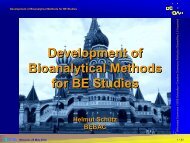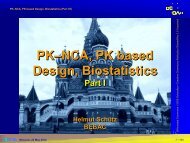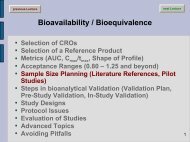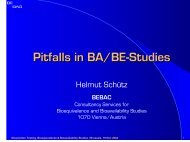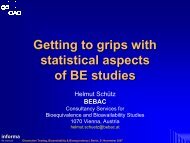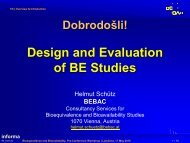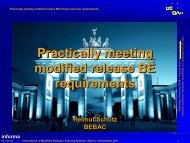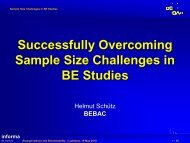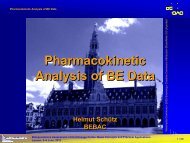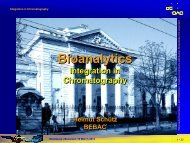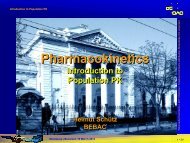Introduction to Bioequivalence - BEBAC ⢠Consultancy Services for ...
Introduction to Bioequivalence - BEBAC ⢠Consultancy Services for ...
Introduction to Bioequivalence - BEBAC ⢠Consultancy Services for ...
You also want an ePaper? Increase the reach of your titles
YUMPU automatically turns print PDFs into web optimized ePapers that Google loves.
<strong>Introduction</strong> <strong>to</strong> <strong>Bioequivalence</strong><strong>Bioequivalence</strong> StudiesREALITY…REALITY…REALITY…REALITY…Reference product (MR / IR)Reference product (MR / IR)Defining study objectivesAdhering <strong>to</strong> guidelinesAdhering <strong>to</strong> guidelinesEthical considerationsEthical considerationsPro<strong>to</strong>col developmentdevelopmentFasting / fedAssessing Assessing clinical clinical and safety safetylabora<strong>to</strong>ry labora<strong>to</strong>ry facilities facilitiesSelecting CROsSelecting CROsSingle dose / multiple multiple doseSelecting Selecting subjectsMoscow, 23 May 20124 • 30
<strong>Introduction</strong> <strong>to</strong> <strong>Bioequivalence</strong>Overview<strong>Bioequivalence</strong>Surrogate of clinical equivalence orMeasure of pharmaceutical quality?Types of studiesPharmacokinetic (PK)Pharmacodynamic (PD)Clinical (equivalence and/or safety/efficacy)Moscow, 23 May 2012 5 • 30
<strong>Introduction</strong> <strong>to</strong> <strong>Bioequivalence</strong>OverviewTypes of studies (cont’d)Healthy SubjectsPatientsSingle doseMultiple doseCross-over, replicateParallelReference product (MR, IR, solution)Moscow, 23 May 2012 6 • 30
<strong>Introduction</strong> <strong>to</strong> <strong>Bioequivalence</strong>OverviewTypes of studies (cont’d)Food effectPK interactionDesign IssuesDose regimenFasted / fed stateType of standard mealsBioanalytics (not GLP!)Parent drug / metabolite(s) / enantiomers / pro-drugsValidation / routine applicationMoscow, 23 May 2012 7 • 30
<strong>Introduction</strong> <strong>to</strong> <strong>Bioequivalence</strong>OverviewEthics (GCP!)Dose levels / number of administered dosesNumber / volume of blood samplesDrug and/or adverse effectsClinical per<strong>for</strong>mance (GCP!)CRO selectionResponsibilities of sponsor / investiga<strong>to</strong>rAudits / moni<strong>to</strong>ringMoscow, 23 May 2012 8 • 30
<strong>Introduction</strong> <strong>to</strong> <strong>Bioequivalence</strong>OverviewNCA / PK (PD)Sampling scheduleMetrics (AUC, C max ; AUEC, Ae max ,…)Design, methods, evaluationSample sizeEstimation from previous and/or pilot studies,literatureHighly variable drugsBiostatisticsModels & assumptionsPro<strong>to</strong>col, evaluation, reportMoscow, 23 May 2012 9 • 30
<strong>Introduction</strong> <strong>to</strong> <strong>Bioequivalence</strong>Overview‘What if’-scenariosCommon pitfallsBlind review‘Failed’ studiesDeficiency lettersMoscow, 23 May 2012 10 • 30
<strong>Introduction</strong> <strong>to</strong> <strong>Bioequivalence</strong>AssumptionsWorld ‘Truth’αβModel ‘Data’H0HATheory ‘Reality’Moscow, 23 May 2012 11 • 30
<strong>Introduction</strong> <strong>to</strong> <strong>Bioequivalence</strong>TerminologyBioavailabilityrelative BAComparative BAabsolute BA<strong>Bioequivalence</strong>Food effectPK interactionPilot studyMoscow, 23 May 2012 12 • 30
<strong>Introduction</strong> <strong>to</strong> <strong>Bioequivalence</strong>DefinitionsEMEA Guideline on BE (2010)A bioequivalence study is basically a comparative bioavailabilitystudy designed <strong>to</strong> establish equivalencebetween test and reference products. Comparative BA, designed <strong>to</strong> demonstrate BE, reference = innova<strong>to</strong>r’s product.Russian BE Guideline (2008)Two drug preparations are considered <strong>to</strong> be bioequivalentif bioavailability of drug substance is the same.EMEA Human Medicines Evaluation Unit / CPMPGuideline on Investigation of <strong>Bioequivalence</strong>(2010)http://bebac.at/Guidelines.htm - EUMinistry of Health and Social Development Russian FederationDrugs <strong>Bioequivalence</strong> Evaluation (2008)http://bebac.at/Guidelines.htm - RUMoscow, 23 May 2012 13 • 30
<strong>Introduction</strong> <strong>to</strong> <strong>Bioequivalence</strong><strong>Bioequivalence</strong>…Comparative BAtrue experiment; no bibliographic comparisonDesigned <strong>to</strong> demonstrate BEvariability,deviation of test from reference,drop-out rate,…<strong>to</strong> be able (statistical power!) <strong>to</strong> demonstrate BEReference = Innova<strong>to</strong>r’s product#1: BE [90%–125%]#2: BE [80%–110%]#3: not BE [76%–103%]; (but ‘BE’ <strong>to</strong> #2)Moscow, 23 May 2012 14 • 30
<strong>Introduction</strong> <strong>to</strong> <strong>Bioequivalence</strong><strong>Bioequivalence</strong>…EMA GL on BE (2010)Two medicinal products containing the sameactive substance are considered bioequivalentif they are pharmaceutically equivalent or pharmaceuticalalternatives and their bioavailabilities(rate and extent) after administration in thesame molar dose lie within acceptable predefinedlimits. These limits are set <strong>to</strong>ensure comparable in vivo per<strong>for</strong>mance,i.e. similarity in terms ofsafety and efficacy.Moscow, 23 May 2012 15 • 30
<strong>Introduction</strong> <strong>to</strong> <strong>Bioequivalence</strong><strong>Bioequivalence</strong>…Russian GL on BE (2008)Two drug preparations are considered <strong>to</strong> bebioequivalent if bioavailability of drug substanceis the same. Bioavailability – percentageamount of the drug substance entered systemicblood flow (extent of absorption) and the rate ofthis process (rate of absorption).Moscow, 23 May 2012 16 • 30
<strong>Introduction</strong> <strong>to</strong> <strong>Bioequivalence</strong>Global Harmonization?In almost all regulations two PK metrics are necessary<strong>to</strong> demonstrate BE, namelyextent (AUC <strong>to</strong>r AUC ∞) andrate (C max) of exposure.One exception: US-FDA (where AUC t and AUC ∞ mustdemonstrate extent of exposure)Although stated in the GL, such a requirementis statistically flawed. Multiplicity issues (what is the patient’s risk?) Impossible α-adjustment (interdependence)There can be only one!Moscow, 23 May 2012 17 • 30
<strong>Introduction</strong> <strong>to</strong> <strong>Bioequivalence</strong>His<strong>to</strong>ry of BE<strong>Bioequivalence</strong>Problems first noticed with NTIDs (NarrowTherapeutic Index Drugs) in the late 1970sIn<strong>to</strong>xications (and even some fatallities!) werereported (warfarin, digoxin, pheny<strong>to</strong>in)Warfarin, digoxin: Patients switched between<strong>for</strong>mulations which were got approval solely basedon in vitro data (innova<strong>to</strong>r ↔generic)Pheny<strong>to</strong>in: The innova<strong>to</strong>r’s API was changed from amicrocrystalline <strong>to</strong> an amorphous <strong>for</strong>m resulting in10times higher plasma concentrations in steady stateMoscow, 23 May 2012 18 • 30
<strong>Introduction</strong> <strong>to</strong> <strong>Bioequivalence</strong>His<strong>to</strong>ry of BE<strong>Bioequivalence</strong>Surrogate of clinical equivalence (1980+)Studies in steady state in order <strong>to</strong> reduce variabilityStudies based on active metaboliteWider acceptance range if clinical justifiable(not FDA!)Measure of pharmaceutical quality (2000+)Single dose studies preferredGenerally parent drugWidening of acceptance range exceptional(except FDA HVDs and EMA C maxof HVDs)Moscow, 23 May 2012 19 • 30
<strong>Introduction</strong> <strong>to</strong> <strong>Bioequivalence</strong>Early 1980sFirst methodFDA’s 75/75 RuleBE, if 75% of subjectsshow ratios of 75%-125%.Not a statistic, variable<strong>for</strong>mulations may pass bychance…BE CabanaAssessment of 75/75 Rule: FDA ViewpointJ Pharm Sci 72, 98-99 (1983)JD HaynesFDA 75/75 Rule: A ResponseJ Pharm Sci 72, 99-100 (1983)T R T/R 75%-125%1 71 81 87.7% yes2 61 65 93.8% yes3 80 94 85.1% yes4 66 74 89.2% yes5 94 54 174.1% no6 97 63 154.0% no7 70 85 82.4% yes8 76 90 84.4% yes9 54 53 101.9% yes10 99 56 176.8% no11 83 90 92.2% yes12 51 68 75.0% yes75.0%Moscow, 23 May 2012 20 • 30
<strong>Introduction</strong> <strong>to</strong> <strong>Bioequivalence</strong>Mid 1980s IEarly methodTesting <strong>for</strong> a significantdifference (t-test) at α 0.05Problem: High variability in differences→ <strong>for</strong>mulation will pass (p ≥ 0.05) Low variability in differences→ <strong>for</strong>mulation will fail (p < 0.05) This is counterintuitive andthe opposite of what we actuallywant!T R T–R1 71 81 -102 61 65 -43 80 94 -144 66 74 -85 94 54 +406 97 63 +347 70 85 -158 76 90 -149 54 53 +110 99 56 +4311 83 90 -712 51 68 -17mean 75 73 +2SD 16 15 23CV% 21.4% 20.6% 940%t -table 2.2010t -calc 0.3687n.s.Moscow, 23 May 2012 21 • 30
<strong>Introduction</strong> <strong>to</strong> <strong>Bioequivalence</strong>Example2520Epanutin (Acid, Parke Davis): ReferencePhenhydan (Acid, Desitin): F=151% (p>0.05)Epilan-D (Na-salt, Gerot): F=139% (p>0.05)Difhydan (Ca-salt, Leo): F=22% (p
<strong>Introduction</strong> <strong>to</strong> <strong>Bioequivalence</strong>Mid 1980s IILater methodFDA’s 80/20 ruleAt least 80% power <strong>to</strong> be able<strong>to</strong> demonstrate a 20%difference (t-test) at α 0.05 Essentially the 75/75 rule inmore statistical terms. Power 71.5% < 80! (not BE) In any study (even at ‘true’ T=R)with variabilitys 2 n > 6.44it is impossible <strong>to</strong> show BE!T R T–R1 71 81 -102 61 65 -43 80 94 -144 66 74 -85 94 54 +406 97 63 +347 70 85 -158 76 90 -149 54 53 +110 99 56 +4311 83 90 -712 51 68 -17mean 75 73 +2SD 16 15 23t -table 2.2010t -calc 0.3687n.s.power 71.59%Moscow, 23 May 2012 23 • 30
<strong>Introduction</strong> <strong>to</strong> <strong>Bioequivalence</strong>Late 1980sTOST (Two One-Sided Tests)First <strong>for</strong>mulation of the problembased on equivalencerather than a difference Two One-Sided t-tests Bioequivalent ifp(120%) ≤0.05 Equivalent <strong>to</strong> a 90% confidenceinterval within an acceptancerange of 80% – 120%DA SchuirmannA Comparison of the Two One-Sided Tests Procedure and thePower Approach <strong>for</strong> Assessing the Equivalence ofAverage BioavailabilityJ Pharmacokin Biopharm 15, 657–680 (1987)T R T–R1 71 81 -102 61 65 -43 80 94 -144 66 74 -85 94 54 +406 97 63 +347 70 85 -158 76 90 -149 54 53 +110 99 56 +4311 83 90 -712 51 68 -17p(120%) 0.0344p(<strong>to</strong>tal) 0.0414T/R 103.32%90% CI (lo) 88.35%90% CI (hi) 118.30%Moscow, 23 May 2012 24 • 30
<strong>Introduction</strong> <strong>to</strong> <strong>Bioequivalence</strong>Human Guineapigs IBE studies as a surrogate <strong>for</strong> clinical efficacy /safety (‘essential similarity’)We want <strong>to</strong> get unbiased estimates, i.e., the pointestimate from the study sample …XˆTestPE =XˆReference… should be representative <strong>for</strong> the population ofpatients.µTestFPop=µReferenceMoscow, 23 May 2012 25 • 30
<strong>Introduction</strong> <strong>to</strong> <strong>Bioequivalence</strong>Human Guineapigs IIBE studies as a special case of documentedpharmaceutical qualityThe in vivo release in the biostudy …XˆTestPE =XˆReference… should be representative <strong>for</strong> the in vitroper<strong>for</strong>mance.f2⎡⎢⎢= 50 ⋅ log ⎢⎢⎢⎢⎢⎣1+t=n∑t=1100⎡⎣R( t) − T ( t)⎤⎦n2⎤⎥⎥⎥⎥⎥⎥⎥⎦Moscow, 23 May 2012 26 • 30
<strong>Introduction</strong> <strong>to</strong> <strong>Bioequivalence</strong>Science → RegulationsWe can’t compare bioavailabilities in theentire population of patientsScientific Reductionism (based on assumptions)‘Similar’ concentrations in healthy subjects willlead <strong>to</strong> ‘similar’ effects in patients.Equal doses and inter-occasion clearances!DT ⋅ FT DR ⋅ FRAUCT= , AUCR=CLCL[ D = ɶ D , CL = ɶ CL ]FrelT R T R( BA)FFTT= =RɶAUCAUCTRMoscow, 23 May 2012 27 • 30R
<strong>Introduction</strong> <strong>to</strong> <strong>Bioequivalence</strong>Models vs. RealityMoscow, 23 May 2012 28 • 30
<strong>Introduction</strong> <strong>to</strong> <strong>Bioequivalence</strong>A ReminderRoseis a roseis a roseis a rose. Gertrude Stein (1913)Guidelinesare guidelinesare guidelines.Henrike Potthast (ca. 2004)In advanced engineering, you expected failure; you learnedas much from failures as from successes – indeed if younever suffered a failure you probably weren’t t pushing theenvelope ambitiously enough.Stephen Baxter; Transcendent, Chapter 36 (2006)Moscow, 23 May 2012 29 • 30
<strong>Introduction</strong> <strong>to</strong> <strong>Bioequivalence</strong>Thank You!<strong>Introduction</strong> <strong>to</strong><strong>Bioequivalence</strong>Open Questions?Helmut Schütz<strong>BEBAC</strong><strong>Consultancy</strong> <strong>Services</strong> <strong>for</strong><strong>Bioequivalence</strong> and Bioavailability Studies1070 Vienna, Austriahelmut.schuetz@bebac.atMoscow, 23 May 201230 • 30




